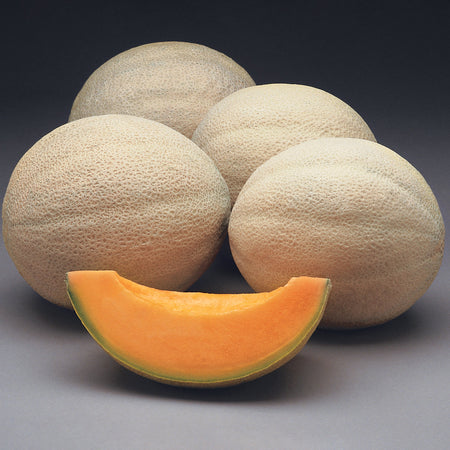ATHENA
Product Description:
| Soil Temp for Germ | 70–85°F |
| Seed Depth | ½" |
| Days to Emergence | 3–10 |
| Soil Temp for Transp | 60°F |
| Plant Spacing | 3–4' |
| Row Spacing | 5–6' |
| Fertilizer Needs | High |
| Minimum Germination | 80% |
| Seeds per Gram | ≈ 20–40 |
| Seed Life | 3 years |
Melons: Cucumis melo
Watermelons: Citrullus lanatus
The sweet succulence of summer-ripe melons is irresistibly tempting, but the health benefits of these luscious fruits shouldn't be overlooked. Look to red-fleshed melons to fortify the heart and urinary tract. Yellow and orange flesh types provide support to the immune system, heart and vision. Green-fleshed varieties promote strong bones and teeth as well as vision health. We've selected varieties that are successful in both southern and northern gardens.
Days to maturity are calculated from transplant date.
Culture
• Melons and watermelons perform best in fertile, well-drained soil with a pH of 6.0-7.0
• Apply 1/2 cup of TSC's Complete fertilizer and a shovelful of compost to each plant
• Watermelons are less tolerant of cool conditions than melons — the use of plastic mulch or floating row cover is highly recommended
• Monitor the temperature under the row covers on hot days, especially early in the season
• Remove covers prior to flowering for pollination
Direct Sowing
• Soil temperature is critical for good germination and only recommended in warmer climates
Transplanting
• Start indoors in 4 inch pots, 3-4 weeks before anticipated transplant date
• Grow the seedlings under dry, warm conditions
• Avoid letting starts get root bound; transplant carefully as to not disturb roots
• Fertilize seedlings with a balanced liquid fertilizer, such as Age Old Grow
Insects & Diseases
• Common insects: Cucumber beetles
• Insect control: Pyrethrin and row covers
• Common diseases: Bacterial wilt and powdery mildew
• Disease control: Zonix
• Disease prevention: 3-4 year crop rotation, avoid overhead watering
Harvest & Storage
• Cantaloupe will easily slip from vine when ripe
• With other melons, check the leaf where fruit is attached to the vine — fruit is mature when this leaf begins to yellow
• Watermelons are ready for harvest when the tendril closest to the fruit is dry and brown or when the bottom side of the fruit is yellow
• Melons and watermelons will not ripen off vine
• Pick in the cool of the day and chill quickly
• Melons: store at 40°F and 95% relative humidity
• Watermelons: store at 50-60°F and 85% relative humidity
KEY TO MELON DISEASE RESISTANCE AND TOLERANCE
A | Anthracnose
AB | Early (Alternaria) Blight
F* | Fusarium Wilt
MNSV | Melon Necrotic Spot Virus
PM* | Powdery Mildew
PRV | Papaya Ringspot Virus
WMV | Watermelon Mosaic Virus
ZYMV | Zucchini Yellow Mosaic Virus
*Numbers indicate specific disease race.


